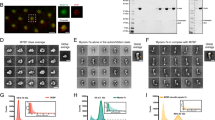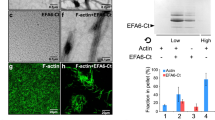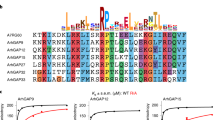Abstract
Motility requires protrusive activity at the cellular edge, where Rho family members regulate actin dynamics. Here we show that p95-APP1 (ArfGAP-putative, Pix-interacting, paxillin-interacting protein 1), a member of the GIT1/PKL family, is part of a complex that interacts with Rac. Wild-type and truncated p95-APP1 induce actin-rich protrusions mediated by Rac and ADP-ribosylation factor 6 (Arf6). Distinct p95-APP1-derived polypeptides have different distributions, indicating that p95-APP1 cycles between the cell surface and endosomes. Our results show that p95-APP1 functionally interacts with Rac and localizes to endosomal compartments, thus identifying p95-APP1 as a molecular link between actin organization, adhesion, and membrane transport during cell motility.
This is a preview of subscription content, access via your institution
Access options
Subscribe to this journal
Receive 12 print issues and online access
$209.00 per year
only $17.42 per issue
Buy this article
- Purchase on Springer Link
- Instant access to full article PDF
Prices may be subject to local taxes which are calculated during checkout










Similar content being viewed by others
References
Mitchinson, T. J. & Cramer, L. P. Actin-based cell motility and cell locomotion. Cell 84, 371–379 (1996).
Hall, A. Rho GTPases and the actin cytoskeleton. Science 279, 509-514 (1998).
Ridley, A. J. Rho: theme and variations. Curr. Biol. 6, 1256-1264 (1996).
Ridley, A. J., Paterson, H. F., Johnston, C. L., Diekmann, D. & Hall, A. The small GTP-binding protein Rac regulates growth factor-induced membrane ruffling. Cell 70, 401–410 (1992).
Bretscher, M. S. & Aguado-Velasco, C. Membrane traffic during cell locomotion. Curr. Opin. Cell Biol. 10, 537–541 (1998).
Hopkins, C. R., Gibson, A., Shipman, M., Strickland, D. K. & Trowbridge, I. S. In migrating fibroblasts, recycling receptors are concentrated in narrow tubules in the pericentriolar area, and then routed to the plasma membrane of the leading lamella. J. Cell Biol. 125, 1265–1274 (1994).
Bretscher, M. S. & Aguado-Velasco, C. EGF induces recycling membrane to form ruffles. Curr. Biol. 8, 721–724 (1998).
Lamaze, C., Chuang, T. H., Terlecky, L. J., Bokoch, G. M. & Schmid, S. L. Regulation of receptor-mediated endocytosis by Rho and Rac. Nature 382, 177–179 (1996).
Murphy, C. et al. Endosome dynamics regulated by a Rho protein. Nature 384, 427–431 ( 1996).
D’Souza-Schorey, C., Li, G., Colombo, M. I. & Stahl, P. D. A regulatory role for ARF6 in receptor-mediated endocytosis. Science 267, 1175– 1178 (1995).
Peters, P. J. et al. Overexpression of wild-type and mutant ARF1 and ARF6: distinct perturbations of nonoverlapping membrane compartments. J. Cell Biol. 128, 1003–1017 ( 1995).
Radhakrishna, H., Klausner, R. D. & Donaldson, J. G. Aluminum fluoride stimulates surface protrusions in cells overexpressing the ARF6 GTPase. J. Cell Biol. 134, 935–947 (1996).
D’Souza-Schorey, C., Boshans, R. L., McDonough, M., Stahl, P. D. & Van Aelst, L. A role for POR1, a Rac-interacting protein, in Arf6-mediated cytoskeletal rearrangements. EMBO J. 16, 5445–5454 (1997).
Radhakrishna, H., Al-Awar, O., Khachikian, Z. & Donaldson, J. G. ARF6 requirement for Rac ruffling suggests a role for membrane trafficking in cortical actin rearrangements. J. Cell Sci. 112, 855–866 (1999).
Kanoh, H., Williger, B. T. & Exton, J. H. Arfaptin 1, a putative cytosolic target protein of ADP-ribosylation factor, is recruited to Golgi membranes. J. Biol. Chem. 272, 5421–5429 ( 1997).
Van Aelst, L., Joneson, T. & Bar-Sagi, D. Identification of a novel Rac1-interacting protein involved in membrane ruffling. EMBO J. 15, 3778– 3786 (1996).
Bagrodia, S. & Cerione, R. A. Pak to the future. Trends Cell Biol. 9, 350–399 (1999).
Premont, R. T. et al. β2-Adrenergic receptor regulation by GIT1, a G protein-coupled receptor kinase-associated ADP ribosylation factor GTPase-activating protein. Proc. Natl Acad. Sci. USA 95, 14082– 14087 (1998).
Bagrodia, S. et al. A tyrosine-phosphorylated protein that binds to an important regulatory region on the cool family of p21-activated kinase-binding proteins . J Biol. Chem. 274, 22393– 22400 (1999).
Turner, C. E. et al. Paxillin LD4 motif binds PAK and PIX through a novel 95-kD ankyrin repeat, ARF-GAP protein: a role in cytoskeletal remodeling. J. Cell Biol. 145, 851–863 (1999).
Turner, C. E., Glenney, J. R. & Burridge, K. Paxillin: a new vinculin-binding protein present in focal adhesions. J. Cell Biol. 111, 1059–1068 (1990).
Nagase, T., Seki, N., Tanaka, A., Ishikawa, K. & Nomura, N. Prediction of the coding sequences of unidentified human genes. IV. The coding sequences of 40 new genes (KIAA 0121-KIAA 0160) deduced by analysis of cDNA clones from human cell line KG-1. DNA Res. 2, 167–174 ( 1995).
Daniels, R. H. & Bokoch, G. M. p21-activated protein kinase: a crucial component of morphological signaling? Trends Biol. Sci. 24, 350–355 ( 1999).
Bagrodia, S., Taylor, S. J., Jordan, K. A., Van Aelst, L. & Cerione, R. A. A novel regulator of p21-activated kinases. J. Biol. Chem. 273, 23633– 23636 (1998).
Manser, E. et al. PAK kinases are directly coupled to the PIX family of nucleotide exchange factors. Mol. Cell 1, 183– 192 (1998).
Oh, W. K. et al. Cloning of a SH3 domain-containing proline-rich protein, p85SPR, and its localization in focal adhesion. Biochem. Biophys. Res. Commun. 235, 794-798 (1997).
Malosio, M. L., Gilardelli, D., Paris, S., Albertinazzi, C. & de Curtis, I. Differential expression of distinct members of the Rho family of GTP-binding proteins during neuronal development: identification of Rac1B, a new neural-specific member of the family. J.Neurosci. 17, 6717–6728 (1997).
Cattelino, A., Albertinazzi, C., Bossi, M., Critchley, D.R. & de Curtis, I. A cell-free system to study regulation of focal adhesions and of the connected actin cytoskeleton. Mol. Biol. Cell 10, 373–391 ( 1999).
Song, J., Khachikian, Z., Radhakrishna, H. & Donaldson, J. G. Localization of endogenous ARF6 to sites of cortical actin rearrangement and involvement of ARF6 in cell spreading. J. Cell Sci. 111, 2257–2267 (1998).
Albertinazzi, C., Cattelino, A. & de Curtis, I. Rac GTPases localize at sites of actin reorganization during dynamic remodeling of the cytoskeleton of normal embryonic fibroblasts . J Cell Sci. 112, 3821– 3831 (1999).
Rottner, K., Hall, A. & Small, J. V. Interplay between Rac and Rho in the control of substrate contact dynamics. Curr. Biol. 9, 640– 648 (1999).
Chavrier, P. & Goud, B. The role of ARF and Rab GTPases in membrane transport. Curr. Opin. Cell Biol. 11, 466–475 (1999).
Franco, M. et al. EFA6, a sec7 domain-containing exchange factor for ARF6, coordinates membrane recycling and actin cytoskeleton organization. EMBO J. 18, 1480–1491 ( 1999).
Welsh, C. F., Moss, J. & Vaughan, M. Isolation of recombinant ADP-ribosylation factor 6, an approximately 20-kDa guanine nucleotide-binding protein, in an activated GTP-bound state. J. Biol. Chem. 269, 15583–15587 (1994).
Vitale, N. et al. GIT proteins, a novel family of phosphatidylinositol 3,4,5-trisphosphate-stimulated GTPase-activating proteins for ARF6. J. Biol. Chem. 275, 13901–13906 (2000).
Albertinazzi, C., Gilardelli, D., Paris, S., Longhi, R. & de Curtis, I. Overexpression of a neural-specific Rho family GTPase, cRac1B, selectively induces enhanced neuritogenesis and neurite branching in primary neurons. J. Cell Biol. 142, 815–825 (1998).
Laemmli, U. K. Cleavage of structural protiens during the assembly of the head of bacteriaphage T4. Nature 277, 680–685 (1970).
Wilm, M. & Mann, M. Analytical properties of the nanoelectrospray ion source. Anal. Chem. 68, 1– 8 (1996).
Wilm, M. et al. Femtomole sequencing of proteins from polyacrylamide gels by nano-electrospray mass spectrometry. Nature 379, 466–469 (1996).
de Curtis, I., Quaranta, V., Tamura, R. N. & Reichardt, L. F. Laminin receptors in the retina: sequence analysis of the chick integrin α6 subunit. J. Cell Biol. 113, 405– 416 (1991).
Schultz, J., Milpetz, F., Bork, P. & Ponting, C. P. SMART, a simple modular architecture research tool: identification of signalling domains. Proc. Natl Acad. Sci. USA 95, 5857– 5864 (1998).
Tomaselli, K. J., Damsky, C. H. & Reichardt, L. F. Purification and characterization of mammalian integrins expressed by rat neuronal cell line (PC12): evidence that they may function as a/b etherodimeric receptors for collagen IV and laminin. J. Cell Biol. 107, 1241–1252 (1988).
Bernard, V., Pohl, B. P. & Bokoch, G. M. Characterization of Rac and Cdc42 activation in chemoattractant-stimulated human neutrophils using a novel assay for active GTPases. J. Biol. Chem. 274, 13198–13204 ( 1999).
Gaschet, J. & Hsu, V. W. Distribution of ARF6 between membrane and cytosol is regulated by its GTPase cycle. J. Biol. Chem. 274, 20040–20045 (1999).
Bokoch, G. M. et al. A GTPase-independent mechanism of p21-activated kinase activation. Regulation by sphingosine and other biologically active lipids. J. Biol. Chem. 273, 8137–8144 (1998).
Lievremont, J. P., Rizzuto, R., Hendershot, L. & Meldolesi, J. BiP, a major chaperone protein of the endoplasmic reticulum lumen, plays a direct and important role in the storage of the rapidly exchanging pool of Ca2+. J. Biol.Chem. 272, 30873– 30879 (1997).
Acknowledgements
We are grateful to B. Ranscht for the E13 chick-brain cDNA library, to E. Manser and L. Lim for the pXJ40–HA–βPIX plasmid and the anti-PIX antibody, to V. Hsu for the anti-Arf6 antibody, to G. Bokoch for the pCMV6m/Pak1 plasmid and the anti-Pak1 antibody, and to J. Meldolesi for critical reading of the manuscript. The financial support of Telethon-Italy (grant n.1171 to I.d.C.) is gratefully acknowledged. A.D.C. was supported by a fellowship from the Armenise-Harvard Foundation. C.A. was supported by a fellowship from the Italian Federation for Cancer Research (FIRC).
Correspondence and requests for materials should be addressed to I.d.C. The nucleotide sequence of p95-APP1 has been deposited at Genbank under accession number AF216970.
Author information
Authors and Affiliations
Rights and permissions
About this article
Cite this article
Di Cesare, A., Paris, S., Albertinazzi, C. et al. p95-APP1 links membrane transport to Rac-mediated reorganization of actin . Nat Cell Biol 2, 521–530 (2000). https://doi.org/10.1038/35019561
Received:
Revised:
Accepted:
Published:
Issue Date:
DOI: https://doi.org/10.1038/35019561
This article is cited by
-
Beta-Pix-dynamin 2 complex promotes colorectal cancer progression by facilitating membrane dynamics
Cellular Oncology (2021)
-
The guanine nucleotide exchange factor Arhgef7/βPix promotes axon formation upstream of TC10
Scientific Reports (2018)
-
Arf6 recruits the Rac GEF Kalirin to the plasma membrane facilitating Rac activation
BMC Cell Biology (2007)
-
GIT2 represses Crk- and Rac1-regulated cell spreading and Cdc42-mediated focal adhesion turnover
The EMBO Journal (2006)
-
Novel regulatory mechanisms for the Dbl family guanine nucleotide exchange factor Cool-2/α-Pix
The EMBO Journal (2004)



